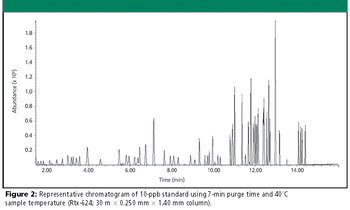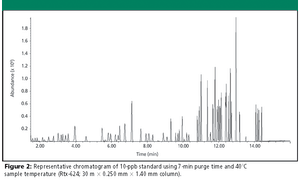
US EPA wastewater method 624 Purgeables was originally published as 40 CFR Part 136 Appendix A in the mid 1980s.
OI Analytical

US EPA wastewater method 624 Purgeables was originally published as 40 CFR Part 136 Appendix A in the mid 1980s.


Shale gas reservoirs, such as the Marcellus shale reserve in Pennsylvania and Barnett shale reserve in Texas are a growing source of natural gas in the United States. Hydraulic fracturing or "fracking" involves pumping water, sand, and chemicals at extremely high pressure into deep underground wells to crack open hydrocarbon-rich shale formations and extract natural gas.

The Clean Air Act (CAA) (1) provides the U.S. Environmental Protection Agency authority to enforce regulations limiting emissions of volatile organic compounds (VOCs) and other air pollutants. The Compendium of Methods for the Determination of Toxic Compounds in Ambient Air includes a variety of sampling and analysis methods (2, 3), including use of single- and multi-sorbent tubes. Concentrating a large volume of sample onto a sorbent tube, followed by thermal desorption onto a GC column provides an efficient, cost-effective means of monitoring VOCs at parts per billion (ppb) or parts per trillion (ppt) levels.

The purge-and-trap (P&T) technique for analysis of volatile organic compounds (VOCs) was pioneered in the 1970s at the United States Environmental Protection Agency (USEPA) research laboratory in Cincinnati. Many of the operational parameters developed during this time period are still included in USEPA methods. While these parameters still produce good analytical results, they do not take advantage of advances in instrumentation that enable analysis of emerging contaminants such as fuel oxygenates, and increased sample throughput.

The purge-and-trap (P&T) technique for analysis of volatile organic compounds (VOCs) was pioneered in the 1970s at the United States Environmental Protection Agency (USEPA) research laboratory in Cincinnati. Many of the operational parameters developed during this time period are still included in USEPA methods. While these parameters still produce good analytical results, they do not take advantage of advances in instrumentation that enable analysis of emerging contaminants such as fuel oxygenates, and increased sample throughput.


Published: September 1st 2013 | Updated:

Published: June 1st 2012 | Updated:

Published: February 1st 2009 | Updated:

Published: February 1st 2008 | Updated:

Published: September 1st 2008 | Updated:

Published: June 1st 2008 | Updated: